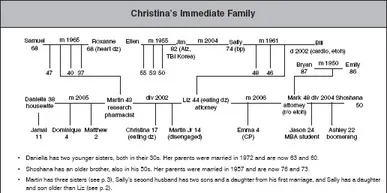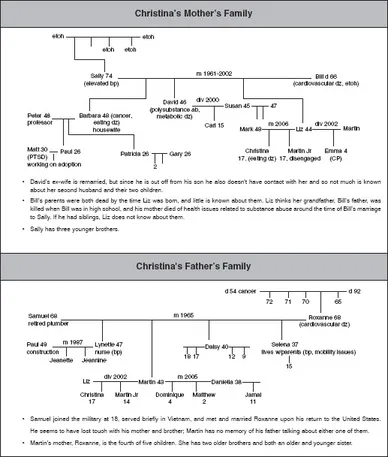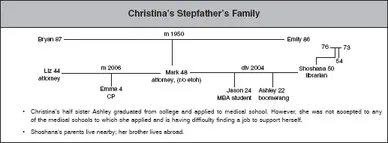
- 368 pages
- English
- ePUB (mobile friendly)
- Available on iOS & Android
eBook - ePub
About this book
"Engaging, Creative, and Practical"
- Lakitta D. Johnson, Jackson State University
Introduction to Family Counseling: A Case Study Approach presents basic knowledge about family counseling and applies various theoretical models to a case example looking at one nuclear family, along with its extended family members, that readers follow throughout the text. Judy Esposito and Abbi Hattem's multi-generational family is constructed from their experiences as professors and family therapists to exemplify the concepts and theories of family counseling. Beyond the theories of family counseling, students learn about the family life cycle and various tools for assessing families as well as the history of family counseling. Ethical issues relevant to family counseling are also included along with transcripts from hypothetical family counseling sessions throughout the book. In addition, the book focuses on working with diverse families and takes special care to emphasize multicultural issues.
- Lakitta D. Johnson, Jackson State University
Introduction to Family Counseling: A Case Study Approach presents basic knowledge about family counseling and applies various theoretical models to a case example looking at one nuclear family, along with its extended family members, that readers follow throughout the text. Judy Esposito and Abbi Hattem's multi-generational family is constructed from their experiences as professors and family therapists to exemplify the concepts and theories of family counseling. Beyond the theories of family counseling, students learn about the family life cycle and various tools for assessing families as well as the history of family counseling. Ethical issues relevant to family counseling are also included along with transcripts from hypothetical family counseling sessions throughout the book. In addition, the book focuses on working with diverse families and takes special care to emphasize multicultural issues.
Frequently asked questions
Yes, you can cancel anytime from the Subscription tab in your account settings on the Perlego website. Your subscription will stay active until the end of your current billing period. Learn how to cancel your subscription.
No, books cannot be downloaded as external files, such as PDFs, for use outside of Perlego. However, you can download books within the Perlego app for offline reading on mobile or tablet. Learn more here.
Perlego offers two plans: Essential and Complete
- Essential is ideal for learners and professionals who enjoy exploring a wide range of subjects. Access the Essential Library with 800,000+ trusted titles and best-sellers across business, personal growth, and the humanities. Includes unlimited reading time and Standard Read Aloud voice.
- Complete: Perfect for advanced learners and researchers needing full, unrestricted access. Unlock 1.4M+ books across hundreds of subjects, including academic and specialized titles. The Complete Plan also includes advanced features like Premium Read Aloud and Research Assistant.
We are an online textbook subscription service, where you can get access to an entire online library for less than the price of a single book per month. With over 1 million books across 1000+ topics, we’ve got you covered! Learn more here.
Look out for the read-aloud symbol on your next book to see if you can listen to it. The read-aloud tool reads text aloud for you, highlighting the text as it is being read. You can pause it, speed it up and slow it down. Learn more here.
Yes! You can use the Perlego app on both iOS or Android devices to read anytime, anywhere — even offline. Perfect for commutes or when you’re on the go.
Please note we cannot support devices running on iOS 13 and Android 7 or earlier. Learn more about using the app.
Please note we cannot support devices running on iOS 13 and Android 7 or earlier. Learn more about using the app.
Yes, you can access Introduction to Family Counseling by Judy Esposito,Abbi Hattem in PDF and/or ePUB format, as well as other popular books in Social Sciences & Education Counseling. We have over one million books available in our catalogue for you to explore.
Information
Part I Introduction to the Family
Chapter 1 The Manning-Kelly Family
Working with families, whether as a human service or mental health professional, physician, or attorney, is challenging and exciting and will allow you to help others and will also leave you changed in the process. What you will learn immediately is that no two families are alike, although certain theories can help guide you as you approach each unique family situation. In this chapter, you will meet the Manning-Kelly family. You will learn about various members of the family, their presenting problem, their family history and dynamics, and how the family counselor put the information together to assess the family and conceptualize an intervention plan.
As you meet and read about the Manning-Kelly family and view its genogram in both this chapter and Chapter 3, you will notice that the family is large and complex, sometimes even confusing. Family counselors frequently discover more complexity than they anticipate when they ask about their clients’ extended families. Fortunately, the tools and family concepts you will learn about help family counselors organize complicated information about the family in ways that are both relevant to the work of family counseling and easier to remember than lists of facts.
Finally, as you read this textbook, please remember that the Manning-Kelly family is not a real family. Rather, it has been created from the authors’ combined experience working with families for the sole purpose of exemplifying the concepts, counseling theories and techniques, and practical considerations you’ll learn about throughout this textbook.
Cast List
Christina: Identified patient, 17-year-old high school junior
Liz: Christina’s mother, 44-year-old attorney
Martin: Christina’s father, 43-year-old research pharmacist
Mark: Christina’s step-father, 48-year-old attorney
Martin Jr (MJ): Christina’s brother, 14-year-old high school freshman
Emma: Christina’s half-sister, 4-year-old daughter of Liz and Mark, cerebral palsy
Daniella: Christina’s step-mother, 38-year-old stay-at-home mother
Jamal: Christina’s step-brother, 11-year-old son of Daniella
Dominique: Christina’s half-sister, 4-year-old daughter of Martin and Daniella
Matthew: Christina’s half-brother, 2-year-old son of Martin and Daniella
Shoshana: Mark’s first wife, 50-year-old librarian
Jason: Christina’s step-brother, Mark’s 24-year-old son, MBA student
Ashley: Christina’s step-sister; Mark’s 22-year-old daughter, boomerang
Barbara: Christina’s aunt, Liz’s 48-year-old sister, housewife, breast cancer
Peter: Barbara’s husband, 48-year-old professor
Paul: Christina’s cousin, 26-year-old son of Barbara and Peter
Matt: Paul’s life partner, 30 years old, PTSD, discharged from military under Don’t Ask Don’t Tell
Patricia: Christina’s cousin, Paul’s twin, 2-year-old daughter, pregnant
Gary: Patricia’s husband
David: Christina’s uncle, Liz’s 46-year-old brother, poly-substance abuse, metabolic disease
Susan: David’s ex-wife, remarried, 2 children with her second husband
Carl: Christina’s cousin, David’s 15-year-old estranged son
Sally: Christina’s grandmother, Liz’s mother, 74 years old, elevated blood pressure
Jim: Christina’s stepgrandfather, Sally’s second husband, Alzheimer’s disease, TBI (traumatic brain injury)
Bill: Christina’s deceased grandfather, Liz’s father, died in 2002 of cardiovascular disease, polysubstance abuse
Samuel: Christina’s grandfather, Martin’s father, 68-year-old retired plumber
Roxanne: Christina’s grandmother, Martin’s mother, 68 years old, cardiovascular disease
Bryan: Christina’s step-grandfather, Mark’s 87-year-old father
Emily: Christina’s step-grandmother, Mark’s 86-year-old mother
Lynette: Christina’s aunt, Martin’s 47-year-old sister, nurse, elevated blood pressure, married with twins Jeannette and Jeanine
Daisy: Christina’s aunt, Martin’s 40-year-old sister, 4 children
Selena: Christina’s aunt, Martin’s 37-year-old sister, blood pressure and mobility issues, lives with her parents and her 15-year-old son
Figure 1.1 Genogram: Christina’s Immediate Family



Note: CP = cerebral palsy; etoh = alcohol abuse; r/o = ruling out; TBI = traumatic brain injury.
Presenting Problem
Families present for counseling with a particular problem they have identified, which family counselors refer to as the presenting problem. The presenting problem usually involves an issue, event, or series of events that has resulted in changed behavior, thoughts, feelings, and external consequences, all of which have resulted in emotional pain.
Family counselors are especially interested in three aspects of the decision to seek counseling. The first involves the details of the presenting problem. Many family counselors ask all family members to describe the reasons they think the family came to counseling. The family counselor might begin with the parent who did not make the initial phone call and then move on to the parent who called. Once both parents have spoken, the counselor asks the children, sometimes beginning with the identified patient and other times beginning with her or his siblings. Sometimes, however, the family counselor asks the children before asking the parent who called to arrange the session.
Some clients are very specific when describing the presenting problem. For example, Liz Manning, the mother in the family we are about to describe, could have answered the family counselor’s question about what brought the family to counseling by listing the challenges the family had experienced over the past few years. She might then have gone on to say that these challenges have led to increased tension throughout the family, and, as a result, she and her husband, Mark, have been distracted from parenting, and their children have suffered.
On the other hand, she could have been vague about the problem. She might have said her children don’t listen and then have been unable to specify what she meant by not listening. Or, she might have relayed that her older daughter’s physician thought they should come to counseling, even though no one else thought there was a problem.
Finally, while it is important for family counselors to know the reasons a family has sought counseling, most family counselors would agree with the following statements:
- A client family is far more than the symptoms and problems that bring the family to counseling, though these symptoms and problems are certainly important. Family members experience emotional, behavioral, and cognitive symptoms that they ascribe to their problems. And their symptoms are, at least in part, a product of these problems. However, just as someone who is depressed may also be a loving spouse and parent, a talented musician or computer programmer, and a valued member of her or his social network, so a family can produce very successful members while experiencing such misery in their interactions that they become depressed, abusive, or withdrawn. To ignore these other aspects, or strengths, of clients and their families dehumanizes them and limits the information available to the counselor and the scope of treatment.
- When a family counselor conflates the symptom or problem with the people in the family, a self-fulfilling prophecy may be created. In other words, the expectation that one or more family member(s) is/are the problem may emerge, further entrapping them in problematic behaviors. Alternatively, when strengths and resources the family already has are utilized to alter family functioning and reduce the symptoms, another, more positive self-fulfilling prophecy may result. Narrative family counselors (see Chapter 8) specifically focus on separating the family from its problem(s) so that the latter can be viewed more objectively and their meaning altered.
The Manning-Kelly family was referred for counseling by their primary care physician (PCP). During a routine physical examination of the 17-year-old daughter, Christina, the doctor noted significant weight loss, irregular menstruation, and some scars on her upper arms and thighs. These observations suggested to the physician that there existed mental health issues beyond what she had time and resources to treat in her practice.
Liz Manning, Christina’s mother, called the family counselor to make an appointment for Christina. Liz told the family counselor she thought the physician was overreacting, but she wanted to make one appointment for her. She indicated that she thought her daughter would be better served by encouragement than by being diagnosed and put into treatment. She said she hoped the family counselor would agree. Liz also stated that she was uncertain Christina would benefit from counseling even if she needed it.
Many questions arose from this description. However, family counselors usually refrain from asking questions in an initial telephone conversation, especially when it is with one person seeking counseling either for someone else or for the family.
Most, though not all, family counselors ask to see the entire family, at least at the first session, because hearing about family dynamics from one member is very different than observing them. Because Christina is an older adolescent, some family counselors might agree to see her individually in recognition of her impending independence, or launching, as family scholars call the stage of the family life cycle during which young adult children leave home (see Chapter 2).
Clients who do not voluntarily seek counseling are often reluctant to fully engage in the process. Christina’s mother initiated the call on the advice of the PCP, rather than at Christina’s request. Thus, enlisting the parents in the process of counseling might increase, though not ensure, the likelihood that Christina would also commit to it.
Like many parents, Liz did not agree with the family counselor’s recommendation to meet with the entire family. Liz warned the counselor that it would be difficult, if not impossible, to coordinate schedules. She indicated that her husband, Mark, did not have time to attend family counseling sessions; her son, Martin Jr., would not be interested; and her younger daughter, Emma, was too young to be there. She then asked whether she could bring Christina for a session without the rest of the family. The family counselor reiterated that she needed to see the entire family, knowing it was important for her to observe the family dynamics in which the mother-daughter dynamics occurred.
At the family counselor’s insistence, Liz agreed to bring the entire family with whom Christina lived to family counseling, and she and the family counselor then arranged a time to meet. The family counselor urged Liz to do everything possible to get everyone there; although she knew, but did not tell Liz, she would see whoever came.
When the family counselor met with the Manning-Kelly family, she learned from Christina’s stepfather, Mark Kelly, that he thought Christina’s concern about her weight was very similar to her mother’s, that neither of them had a weight problem even despite Christina’s thinness, and the real problem was Christina’s arguments with Liz about college. Christina’s mother, Liz, said she agreed that Christina’s weight was not a problem, and Christina’s refusal to explore college options was a concern not warranting family counseling.
Christina’s brother, Martin Jr., said his mother and sister argue most days, and he thought Christina needed to eat more. He said he and Christina rarely talked, and both thought their parents were too controlling. Emma, when asked what she thought, snuggled closer to her mother and looked at her lap.
Identified Patient
Christina was a 17-year-old high school junior, 5’8” tall. She was visibly underweight, having lost more than 10% of her body weight according to her PCP. She appeared wary of the counseling sit...
Table of contents
- Cover
- Half Title
- Acknowledgements
- Publisher Note
- Title Page
- Copyright Page
- Brief Contents
- Acknowledgments
- About the Authors
- Introduction
- Part I Introduction to the Family
- Chapter 1 The Manning-Kelly Family
- Chapter 2 Families and the Family Life Cycle
- Chapter 3 Assessing Families Traditionally and Creatively
- Part II Theories of Family Counseling
- Chapter 4 The Family Systems Approach to Family Counseling
- Chapter 5 Multigenerational Family Counseling
- Chapter 6 Structural Family Counseling
- Chapter 7 Experiential Family Counseling
- Chapter 8 Other Approaches to Family Counseling
- Part III Other Aspects of Family Counseling
- Chapter 9 Special Topics in Family Counseling
- Chapter 10 The Counselor’s Experience Working With Families
- Chapter 11 Ethics of Family Counseling
- Part IV Current Trends in Family Counseling
- Chapter 12 Issues Requiring Services Beyond the Counselor’s Scope of Practice
- Chapter 13 Services Available to Families
- Chapter 14 What’s Next for the Manning-Kelly Family?
- Index